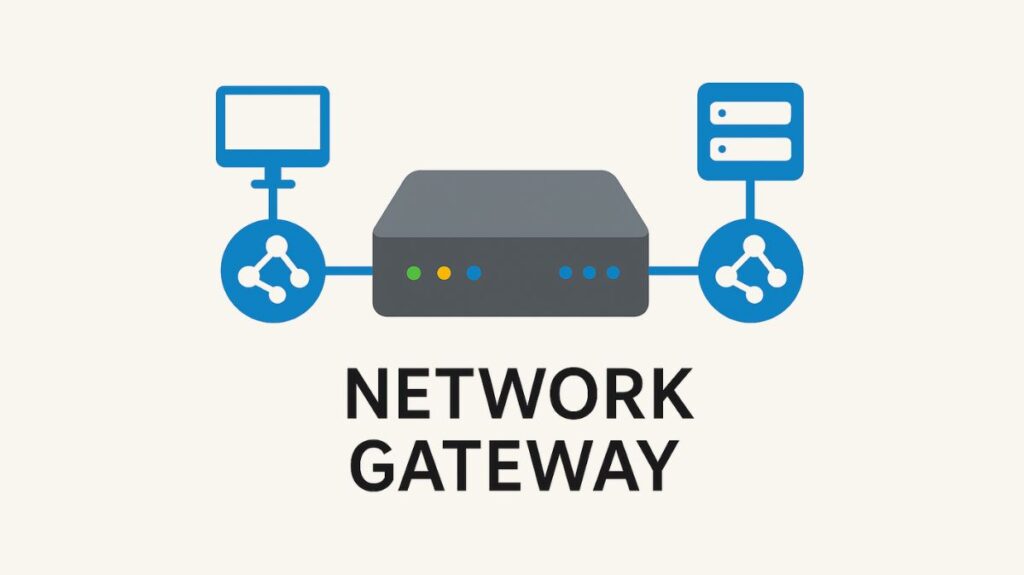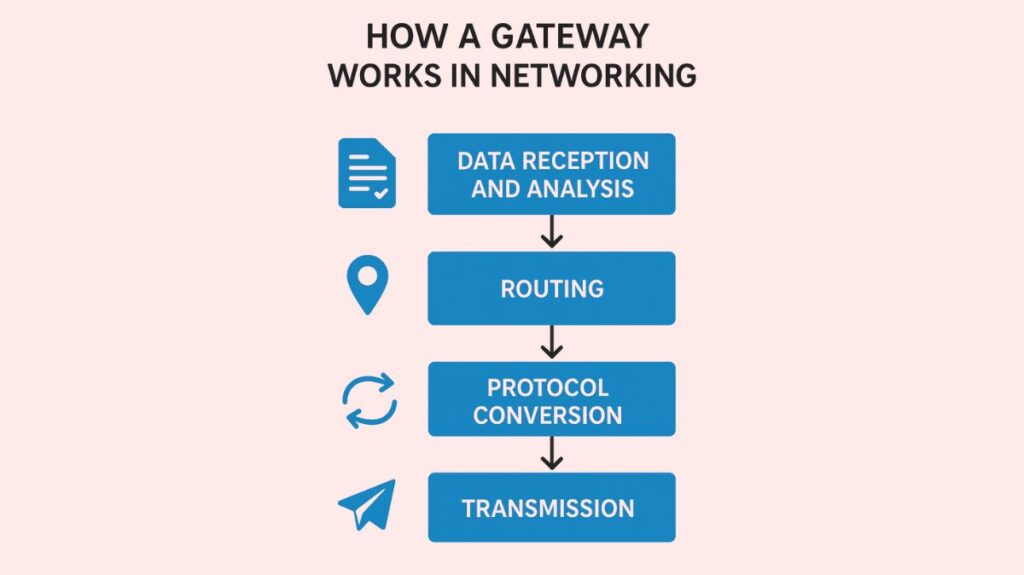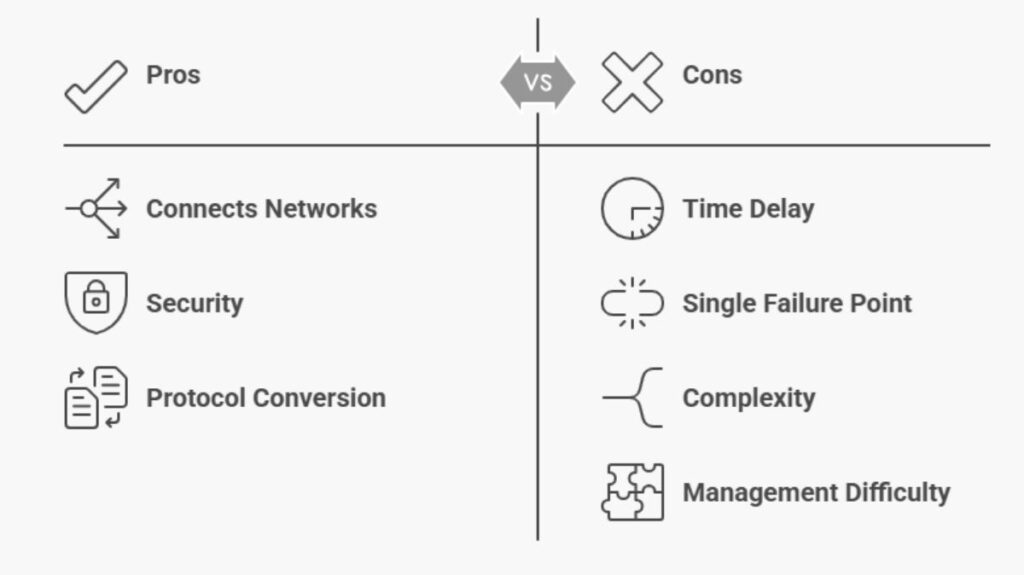This article gives an overview of Network Gateways, How it Work’s, Features, Types, Advantages And Disadvantages Of Gateway.
What is Gateway in Networking

A network gateway is an essential piece of hardware or software that connects two networks using distinct transmission protocols. Since it serves as a network’s entry and departure point, all traffic travelling between disparate networks must go via the gateway. It is sometimes described as a “doorway” connecting several digital domains.
The word “gateway” was once often used to describe a routing device. There was a common usage of the phrases “interior gateways” and “exterior gateways” interchangeably with “interior routers” and “exterior routers” to refer to routers that manage IP packet forwarding. The word “gateway” has, however, lost some of its precision over time, and “router” is now the accepted name for devices that carry out routing tasks.
How does a Gateway Work in Networking

To guarantee smooth communication between incompatible networks, a gateway’s operating technique consists of the following steps:
Data Reception and Analysis: Devices in its network send data to a gateway. After that, it intercepts and carefully examines the incoming data packets, looking at things like payloads and packet headers.
Routing: The gateway directs the data packet according to its analysis, which identifies the proper destination address. It keeps track of the communication networks’ routing routes.
Protocol Conversion: Transforming the received data’s format to make it compatible with the recipient network is one of a gateway’s primary duties. This entails changing protocols or other data packet components that are required. For this reason, gateways are also referred to as protocol converters.
Transmission: The gateway forwards the data packets to the appropriate destination addresses inside the network after they have been examined, routed, and transformed. It transmits data via a packet switching approach.
Features of Gateway in Networking
Numerous functions are available through gateways to control communication across networks:
Boundary Location: Usually located at a network’s edge, a gateway regulates all incoming and outgoing data traffic.
OSI Model Operation: Although it often functions at Layer 3 (the network layer), a gateway may function at any of the seven layers of the OSI (Open Systems Interconnection) architecture, unlike many other network devices. In the past, it also carried out conversion at the application layer.
Traffic Management: Gateways control data flow between networks by routing and managing traffic. By splitting data into smaller packets and queuing it, they simplify transmission.
Security: In terms of network security, gateways are crucial. They can include security features like proxy servers to preserve restricted access and Firewall to filter traffic according to application criteria. Before it enters the network, they may check emails and other types of material for harmful components.
Information Collection: To help diagnose data packets and network activity, they gather information from different parts of the network.
Connectivity: They are necessary to link Wide Area Network (Wan), like the Internet, to Local Area Networks (LANs).
Types of Gateway in Networking
Based on the direction of data flow and their unique features, gateways are often divided into the following categories:
Based on Direction of Data Flow
Unidirectional Gateways: Only one route of data transfer is allowed by these gateways. While modifications performed in the destination node are not replicated back to the source, they are duplicated in the source node. They work well as tools for archiving.
Bidirectional Gateways: Changes may be replicated from source to destination and vice versa with these gateways, which let data to move in both directions. Usually, they serve as synchronization tools.
Based on Functionality
Network Gateway: Serving as an interface between two disparate networks with disparate protocols, this is the most common kind. In general, a network gateway is referred to when the phrase “gateway” is used without more explanation.
Cloud Storage Gateway: By converting storage requests into various cloud storage provider API calls (such as SOAP or REST), this kind of gateway makes it easier to integrate private cloud storage into apps without having to transfer them to a public cloud.
Internet-To-Orbit Gateway (I2O): Project HERMES and GENSO are two examples of these gateways, which link Internet-connected devices to satellites and spacecraft in orbit around the planet.
IoT Gateway: Internet of Things (IoT) gateways gather sensor data from IoT devices, convert the data across different protocols, and then transmit the data to a cloud network. They connect user apps, cloud networks, and Internet of Things devices.
VoIP Trunk Gateway (Voice Gateway): Voice over Internet Protocol (VoIP) networks and traditional phone service (POTS) devices, such landlines and fax machines, may communicate with each other with this bridge.
Default Gateway: It serves as the main point of access to other networks and is frequently a router in a network. Every non-local network connection has to go via the default gateway.
Email Security Gateway: Before letting emails onto the network, it checks them for any harmful material.
Application Gateways: Firewall gateways that filter traffic according to application rules are examples of specialized gateways used for certain applications.
Gateway of Last Resort: When no alternative specified route is known, a certain kind of router gets all unroutable packets.
Corporate Gateway: This phrase describes a destination router that gives distant consumers access to services offered by another Internet service provider (ISP) or even a business network. Through this gateway, remote users may access the corporate LAN just like they would if they were physically there.
Cellular Gateways: Faster 4G and 5G speeds can be facilitated via cellular gateways, allowing cellular data access to serve as the main method of internet communication. For this reason, gateways must be able to convert cellular data into a local network suitable format.
Wireless Gateways: The all-in-one gateway/router that comes with a residential or small business ISP account is also known as a wireless gateway. Both the NIC in the local device and a gateway integrated into the router (to convert the data to Wi-Fi) are involved in wireless access.
Gateways vs. Routers and Switches
Although switches and routers are also network equipment, gateways stand out due to their more intricate features:
Gateways Vs Routers: A gateway performs essential protocol translation to link networks with essentially differing topologies and protocols. On the other hand, a router usually forwards traffic across networks that share the same protocol, such as several Local Area Network subnets. Despite their historical differences, gateways and routers frequently perform the same activities in contemporary devices, such as residential Wi-Fi routers.
Gateway Vs Switch: More complicated, gateways manage traffic across many network types and translate protocols. On the other hand, switches function inside the same network and are principally in charge of sending data to certain devices according to their MAC addresses.
Advantages And Disadvantages Of Gateway

Advantages of Gateway
Connects Dissimilar Networks: Importantly, it uses many protocols to bridge communication between networks.
Security Enforcement: Filters potentially dangerous material and offers strong defence against outside threats.
Protocol Conversion: Ensures data compatibility by serving as an essential protocol converter.
Disadvantages
Time Delay: Time delays may be introduced by data conversion procedures.
Single Point of Failure: The total loss of connectivity to other networks may result from a gateway failure.
Complexity and Cost: It can be costly and complicated to implement.
Management Difficulty: Can be difficult to successfully manage.
Gateways can be implemented as software-configured or as a physical node with several Network Interface Cards (NICs) connected to various networks. Routers and other network equipment are increasingly being designed with modern gateway features integrated right in.
